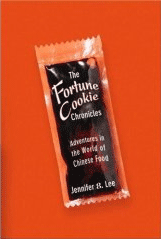« Booklist Review: More a summary than a review | Home | Giving new meaning to “in bed” from fortune cookies. Chinese food pajamas »
The long march of the fortune tea cake?
By Jennifer 8. Lee | January 21, 2008
Barry Popik, a compiler of etymological origins and contributor to the Oxford English Dictionary, has a nice compilation of early citations in newspapers for “fortune tea cakes,” “Chinese fortune cakes,” “fortune cakes” (some of the last one I dispute refer to the modern day fortune cookies because they seem more related to the French galette des rois, which has a trinket embedded inside). (Yay for proquest!)
Among the ones that I find most intriguing are the ones that show fortune tea cakes had spread to Chinese restaurants outside California, albeit in a light, scattered way.
12 February 1921, Sheboygan (WI) Press, pg. 5, col. 5:
Japanese napkins plaited into fan shapes were used and chop suey was served, regular United States sandwiches and rich cakes were a part of the menu, served with tea along with little Japanese fortune cakes, fussy brown cakes that were opened and found to hold all sorts of good lunch for the openers.
10 September 1926, Big Spring (TX) Herald, “Japanese Motif Expressed in Parties for Visitor,†pg. 11, col. 2:
Fortune cookies were served with the main course, and enclosed in each one was a rhyme or fortune, and pretty Japanese parasols were other plate favors.
12-13 April 1934, Modesto (CA) Bee, pg. 4, col. 3:
Tea cakes, fortune tea cakes with rice canapes called osushi were served with the tea in Japanese tea cups.
14 January 1936, El Paso (TX) , pg. 10, col. 8:
A COLD EVENING after a good movie is the ideal time for a hot Chinese dish at THE AZTEC CAFE, 100 E. San Antonio Street. Too, their lunches are 30c, Chinese or American, and include soup, drinks, and Chinese fortune cakes.
3 December 1936, Oakland (CA) Tribune, pg. 15, col. 1:
Chinese fortune cakes were the clever medium to divulge the secret. Served during the cocktail hour, guests found enclosed with their fortunes in the center of these cakes, miniature red hearts inscribed with the names of the young couple.10 July 1937, Lethbridge (Alberta, Canada) Herald, “San Francisco’s Chinatown,†pg. 11, col. 2:
Fortune Cookies
(This appears to be from a Japanese menu, however, also in San Francisco’s Chinatown—ed.)8 January 1939, Fresno (CA) Bee, pg. 8A, col. 1:
The engagement news was disclosed in Chinese fortune cookies which were served with the dessert course.30 January 1940, Nevada State Journal (Reno, NV), pg. 5, col. 1:
To carry out the theme, Chinese food and Chinese fortune cookies were served.25 May 1940, New York (NY) Herald Tribune, Clementine Paddleford column, pg. 18, col. 7:
GOOD FORTUNE—This is served with Chinese fortune cakes, rice cakes really, but in new form. The thin dough has been doubled and folded to resemble a miniature collar. Break the collar in half and a printed fortune is found. Ours read: “Remain among your friends and you will do well,†which seems sound sense. These cakes sell in New York for 35 cents a dozen, are good to eat and good fun to serve at punchbowl parties, not too sweet either, to go nicely with wine.
What is intriguing to me is where these places are getting their fortune tea cakes. In New York at least, there is evidence of fortune cookie factories as of the 1930s (Key Key bakery, owned by the Leong family, was one of the first). But what bout Reno, Nevada and El Paso, Texas? I’m certain there were no fortune cookie factories locally. So was it Umeya (the first mass producer of fortune cookies in Los Angeles)? Hong Kong Noodle (which was the first Chinese-owned producer of fortune tea cakes)?
Topics: Fortune Cookies | No Comments »
Comments are closed.

